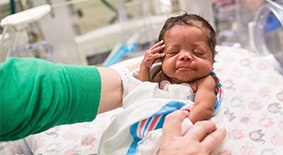Sleep Apnea in Kids and Teens
Updated 7/20/21
Kids and teens who have been diagnosed with sleep apnea often experience a wide range of symptoms that parents should keep an eye (or ear) out for, including being super sleepy during the day or even having behavior issues at school.
Have you ever noticed your child’s breathing pauses while they are sleeping? Has their snoring grown louder than what you remember hearing when they were a toddler? Are they super sleepy during the day? Have you noticed an increase in bad behavior?

These are possible signs of sleep apnea, which is a sleep disorder in which children and teens have a pause in their breathing while sleeping. They may also gasp for air or experience restless sleep.
“We often get the story from parents who were on vacation, sharing a hotel room with their kid, that they noticed their child was snoring really heavily,” says Nikhila R. Raol, MD, MPH, a Pediatric Otolaryngologist at Children’s Healthcare of Atlanta. “And when they returned home, they started paying more attention and became a little concerned about it.”
The criteria for diagnosing sleep apnea in children and teens is different than in adults. If a child has more than one interruption in their breathing each hour, that’s considered obstructive sleep apnea. For adults, however, that cutoff is five pauses in breathing each hour.
Are there different types of sleep apnea in kids and teens?
There are three different types of sleep apnea, including:
- Obstructive sleep apnea, which is when there is tissue blocking a child’s airway during sleep, essentially causing the body to have to make adjustments. This tissue may include your child’s tonsils or adenoids, amongst other tissue in the upper airway.
- Central sleep apnea, which is related to issues with the brain’s respiratory center not sending the appropriate signals to the respiratory muscles while sleeping that reminds a child to breathe. This may also be a result of a brain injury, brain mass, malformations in the brain that could be congenital, or medicines that could cause aspiration or fluid in the airway.
- Mixed sleep apnea, which is a combination of obstructive and central sleep apnea.
While most parents of kids and teens may not be watching their child’s sleep as closely as they did when their child was younger, there are other signs to watch out for while their child is awake. These may include:
- Fatigue
- Fogginess when they wake up
- Issues with bed-wetting
- Issues with teeth grinding
- Significant behavior issues, including hyperactivity
- Chronic congestion
- Mouth breathing
The best way to determine whether a child or teen has sleep apnea is for them to undergo an overnight sleep study in a pediatric sleep lab.
“Having this study done in a pediatric facility can make it easier to have a successful study,” adds Dr. Raol. “It can be hard for children to tolerate the study and sleep with all the sensors placed on them, but our pediatric-trained technicians are great with making kids feel more comfortable.”
Families are typically scheduled to report to one of our sleep labs and will stay overnight, leaving the following morning. The study is conducted in a private room with a parent present. During the sleep study, we monitor your child’s:
- Brain waves
- Breathing
- Heart rate
- Body movements
Following the sleep lab study, a pediatric sleep specialist will read the sleep study results and make a diagnosis.
Once our pediatric sleep specialists determine whether your child has sleep apnea, in addition to which type, we may suggest treatment options, such as:
- Medical therapy, which involves medications that help reduce inflammation, and, potentially, the size of the tissues, such as the adenoids or tonsils, that are causing the obstruction.
- Continuous positive airway pressure (CPAP) therapy, which involves a machine using a hose and mask or nosepiece to deliver constant and steady air pressure to a child while he’s sleeping. Many parents may try this option for moderate to severe diagnoses of sleep apnea before exploring surgical solutions.
- Surgery, which may involve removing the tonsils or adenoids, also called a tonsillectomy or adenoidectomy, or other tissue depending on physical exam findings.
Why should my child or teen’s sleep apnea be treated in a pediatric hospital?
Pediatric specialists are just what their name implies: Doctors, nurses, radiologists, therapists and more who have specialized training in treating children from birth to age 18.
“We are all tuned into the needs of children,” Dr. Raol says. “And when we are making decisions, we consult a child’s caregiver every step of the way to make sure we are doing what’s best for that family—whether that’s surgical or nonsurgical treatment.”
Our multidisciplinary team also takes a careful approach to every complex pediatric case. “We work with our sleep medicine doctors, sleep surgeons, sleep psychologists and a respiratory therapist in an effort to provide the best care possible for each child we see,” says Dr. Raol.
Parents: Helpful Tools and Resources for You
Nikhila P. Raol, MD, joined Children’s Healthcare of Atlanta as a Pediatric Otolaryngologist and Emory University of Medicine Assistant Professor in 2016. She came to Georgia from Boston, Massachusetts, where she completed her fellowship training at Pediatric Otolaryngology, Massachusetts Eye and Ear Infirmary.
This content is general information and is not specific medical advice. Always consult with a doctor or healthcare provider if you have any questions or concerns about the health of a child. In case of an urgent concern or emergency, call 911 or go to the nearest emergency department right away. Some physicians and affiliated healthcare professionals on the Children’s Healthcare of Atlanta team are independent providers and are not our employees.
Contact Us 404-785-KIDS (5437)




